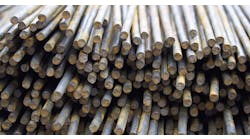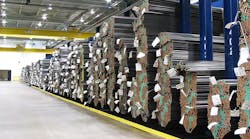The global steel industry produced 1.69 billion metric tons of raw steel during 2017, a 5.3% improvement over the previous year, and posted a second consecutive year of rising output. The total was boosted by increases in all the major steel-producing nations and regions, except for a notable decline in output in Ukraine and an apparent even result in Japan.
The World Steel released its summary report of raw-steel production worldwide, covering more than 160 producers in 66 countries. The Brussels-based organization reports raw-steel output and capacity utilization for raw (or crude) steel — the product of basic oxygen furnaces and electric arc furnaces, and cast into semi-finished products, such as slabs, blooms, or billets. Its monthly report covers carbon and carbon alloy steels; data for production of stainless and specialty alloy steels are reported separately.
The year-end report is in line the World Steel Assn.’s October short-term forecast, in which it pegged projected total 2017 demand to rise slightly to 1.6 billion metric tons, with improved demand in China and the developed economies, less political and social instability in China and elsewhere, and more strength in construction and machinery sectors worldwide.
The Chinese situation continues to shape the global steel market, as that nation’s economic policy continues to call for consolidation of ownership and elimination of “outdated” capacity, in order to control prices and supply. Over the past decade, China has solidified a position as the source of roughly half of all the raw steel produced worldwide, and its role as an exporter of semi-finished steel has impacted regional and global market.
In early January, China’s Ministry of Industry and Information Technology (MIIT) reported that the nation had met its goal of reducing installed capacity by 50 million metric tons/year during 2017, and phased out 120 million metric tons of outdated capacity. MIIT predicted it will meet its 2020 goal of phasing out 150 million metric tons/year of capacity this year (2018.)
"We will strictly forbid any new steel capacity to be launched...and make sure all outdated steel capacity is eliminated and prevented from reopening," MIIT stipulated.
For 2017, the Chinese industry produced 831.7 million metric tons of raw steel during 2017, 5.7% more than during the previous year. Its December output totaled 66.15 million metric tons, a drop of 8.6% from November but a 2.2% rise over December 2016.
The Japanese steelmakers produced 104.7 million metric tons in 2017, just 0.1% less than their 2016.
The Indian steel industry has expanded considerably in the past decade, now ranking as the world’s third largest. Its 2017 tonnage rose 6.2% over 2016 to 101.4 million metric tons.
In the European Union, total 2017 raw-steel output for 28 nations during 2017 was 168.7 million metric tons, up 4.1% compared to 2016. The largest producer nation in the region, Germany, produced 39.96 million metric tons for the year, up 2.86% over the previous year’s total.
Italy produced 24.0 million metric tons in 2017, up 2.9% versus 2016; Spain produced 14.5 million metric tons of raw steel in 2017, up 6.2% compared to 2016; and France produce 14.29 million metric tons, which was a 7.7% year-over-year improvement.
Russia’s steel industry is the world’s fifth-largest, and it produced an estimated 71.3 million metric tons in 2017, up 2.89% versus 2016 totals, though the World Steel Assn. noted the results are based on estimated data.
Ukraine remains the world’s 12th-largest steelmaking nation, though its output has struggled to remain consistent amid political and economic strain in recent years. The nation’s 2017 total estimated output of 19.9 million metric tons is 10.4% less than the year-earlier result.
The U.S. steel industry is the fourth-largest in the world, and reported total 2017 output of 81.6 million metric tons (89.9 million short tons) of raw steel, up by 4.1% versus the 2016 total.












